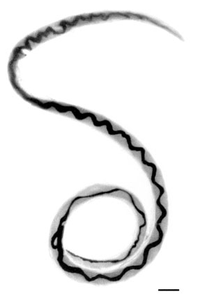
Photo from wikipedia
Sensitivity Analysis (SA) is a useful tool to measure the impact of changes in model parameters on the infection dynamics, particularly to quantify the expected efficacy of disease control strategies.… Click to show full abstract
Sensitivity Analysis (SA) is a useful tool to measure the impact of changes in model parameters on the infection dynamics, particularly to quantify the expected efficacy of disease control strategies. SA has only been applied to epidemic models at the population level, ignoring the effect of within-host virus-with-immune-system interactions on the disease spread. Connecting the scales from individual to population can help inform drug and vaccine development. Thus the value of understanding the impact of immunological parameters on epidemiological quantities. Here we consider an age-since-infection structured vector-host model, in which epidemiological parameters are formulated as functions of within-host virus and antibody densities, governed by an ODE system. We then use SA for these immuno-epidemiological models to investigate the impact of immunological parameters on population-level disease dynamics such as basic reproduction number, final size of the epidemic or the infectiousness at different phases of an outbreak . As a case study, we consider Rift Valley Fever Disease utilizing parameter estimations from prior studies. SA indicates that $$1\%$$ 1 % increase in within-host pathogen growth rate can lead up to $$8\%$$ 8 % increase in $$\mathcal R_0,$$ R 0 , up to $$1 \%$$ 1 % increase in steady-state infected host abundance, and up to $$4\%$$ 4 % increase in infectiousness of hosts when the reproduction number $$\mathcal R_0$$ R 0 is larger than one. These significant increases in population-scale disease quantities suggest that control strategies that reduce the within-host pathogen growth can be important in reducing disease prevalence.
Journal Title: Bulletin of Mathematical Biology
Year Published: 2022
Link to full text (if available)
Share on Social Media: Sign Up to like & get
recommendations!